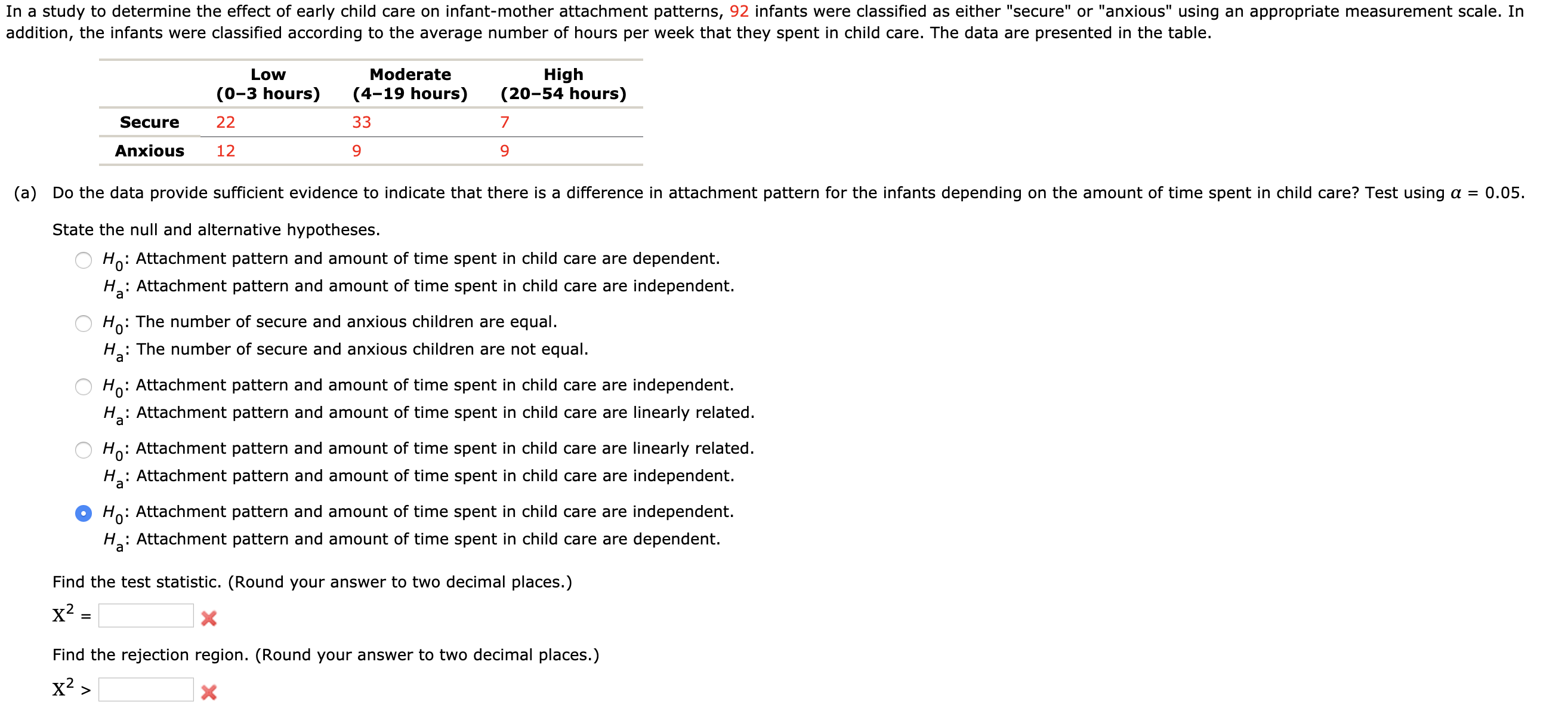In a study to determine the effect of early child care on infant-mother attachment patterns, 92 infants were classified as either "secure" or "anxious" using an appropriate measurement scale. In addition, the infants were classified according to the average number of hours per week that they spent in child care. The data are presented in the table. High (20-54 hours) Low Moderate (0-3 hours) (4-19 hours) Secure 22 33 Anxious 12 9. 9. (a) Do the data provide sufficient evidence to indicate that there is a difference in attachment pattern for the infants depending on the amount of time spent in child care? Test using a = 0.05. State the null and alternative hypotheses. Ho: Attachment pattern and amount of time spent in child care are dependent. H: Attachment pattern and amount of time spent in child care are independent. Ho: : The number of secure and anxious children are equal. : The number of secure and anxious children are not equal. Ha : Attachment pattern and amount of time spent in child care are independent. Ho : Attachment pattern and amount of time spent in child care are linearly related. На a' : Attachment pattern and amount of time spent in child care are linearly related. Ho: На: : Attachment pattern and amount of time spent in child care are independent. Ho: Attachment pattern and amount of time spent in child care are independent. H: Attachment pattern and amount of time spent in child care are dependent. Find the test statistic. (Round your answer to two decimal places.) x? = Find the rejection region. (Round your answer to two decimal places.) x? >
In a study to determine the effect of early child care on infant-mother attachment patterns, 92 infants were classified as either "secure" or "anxious" using an appropriate measurement scale. In addition, the infants were classified according to the average number of hours per week that they spent in child care. The data are presented in the table. High (20-54 hours) Low Moderate (0-3 hours) (4-19 hours) Secure 22 33 Anxious 12 9. 9. (a) Do the data provide sufficient evidence to indicate that there is a difference in attachment pattern for the infants depending on the amount of time spent in child care? Test using a = 0.05. State the null and alternative hypotheses. Ho: Attachment pattern and amount of time spent in child care are dependent. H: Attachment pattern and amount of time spent in child care are independent. Ho: : The number of secure and anxious children are equal. : The number of secure and anxious children are not equal. Ha : Attachment pattern and amount of time spent in child care are independent. Ho : Attachment pattern and amount of time spent in child care are linearly related. На a' : Attachment pattern and amount of time spent in child care are linearly related. Ho: На: : Attachment pattern and amount of time spent in child care are independent. Ho: Attachment pattern and amount of time spent in child care are independent. H: Attachment pattern and amount of time spent in child care are dependent. Find the test statistic. (Round your answer to two decimal places.) x? = Find the rejection region. (Round your answer to two decimal places.) x? >
Glencoe Algebra 1, Student Edition, 9780079039897, 0079039898, 2018
18th Edition
ISBN:9780079039897
Author:Carter
Publisher:Carter
Chapter10: Statistics
Section10.6: Summarizing Categorical Data
Problem 4AGP
Related questions
Question

Transcribed Image Text:In a study to determine the effect of early child care on infant-mother attachment patterns, 92 infants were classified as either "secure" or "anxious" using an appropriate measurement scale. In
addition, the infants were classified according to the average number of hours per week that they spent in child care. The data are presented in the table.
High
(20-54 hours)
Low
Moderate
(0-3 hours)
(4-19 hours)
Secure
22
33
Anxious
12
9.
9.
(a) Do the data provide sufficient evidence to indicate that there is a difference in attachment pattern for the infants depending on the amount of time spent in child care? Test using a = 0.05.
State the null and alternative hypotheses.
Ho: Attachment pattern and amount of time spent in child care are dependent.
H: Attachment pattern and amount of time spent in child care are independent.
Ho:
: The number of secure and anxious children are equal.
: The number of secure and anxious children are not equal.
Ha
: Attachment pattern and amount of time spent in child care are independent.
Ho
: Attachment pattern and amount of time spent in child care are linearly related.
На
a'
: Attachment pattern and amount of time spent in child care are linearly related.
Ho:
На:
: Attachment pattern and amount of time spent in child care are independent.
Ho: Attachment pattern and amount of time spent in child care are independent.
H: Attachment pattern and amount of time spent in child care are dependent.
Find the test statistic. (Round your answer to two decimal places.)
x? =
Find the rejection region. (Round your answer to two decimal places.)
x? >
Expert Solution
This question has been solved!
Explore an expertly crafted, step-by-step solution for a thorough understanding of key concepts.
This is a popular solution!
Trending now
This is a popular solution!
Step by step
Solved in 4 steps with 3 images

Recommended textbooks for you

Glencoe Algebra 1, Student Edition, 9780079039897…
Algebra
ISBN:
9780079039897
Author:
Carter
Publisher:
McGraw Hill

College Algebra (MindTap Course List)
Algebra
ISBN:
9781305652231
Author:
R. David Gustafson, Jeff Hughes
Publisher:
Cengage Learning

Glencoe Algebra 1, Student Edition, 9780079039897…
Algebra
ISBN:
9780079039897
Author:
Carter
Publisher:
McGraw Hill

College Algebra (MindTap Course List)
Algebra
ISBN:
9781305652231
Author:
R. David Gustafson, Jeff Hughes
Publisher:
Cengage Learning